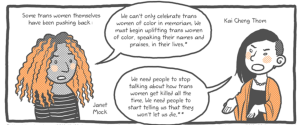One of the most common objections to feminism is that gender roles are based on science, and by challenging them, feminists are going against nature.
The media abounds with studies that supposedly demonstrate evolutionary differences between men and women. However, many of these studies are dubious, while a lot of science challenging the innateness of gender roles is not.
Popular magazines present evolutionary theories as to why men are better at math, women are more emotional, men are more promiscuous, and so on – you’ve heard them. So, when I studied Gender and Sexuality Studies alongside Cognitive Neuroscience in college, I expected these fields to come into conflict.
But I was surprised: Much of what I learned in my biology and psychology courses supported my readings in feminist and queer theory.
Here are a few empirically backed facts I’ve learned that show science really supports feminism, not gender essentialism.
1. There Are More Than Two Sexes, Not to Mention a Vast Range of Gender Identities
Most scientific theories claiming that gendered behavior is innate attribute it to our genetics – specifically, whether we have two X chromosomes (typically considered female) or an X and a Y (typically considered male).
However, intersex, transgender, and otherwise gender non-conforming people challenge the notion that gender expression is tied to chromosomes, genitalia, hormones, and other physical characteristics often cited as the basis for femininity and masculinity.
Even biologists are starting to acknowledge that there are more than two sexes.
In the paper “The Five Sexes” (which actually argues there are more than five), Brown University professor Anne Fausto-Sterling points out that sex exists in a continuum, with intersexuals (people who don’t have all the physical characteristics of males or females) constituting about 4% of births. That’s 1-in-25 people!
This number seems shockingly high because surgical intervention often follows birth, so we don’t meet a lot of people who identify as intersexuals into adulthood (and even if we did, we might not know).
However, intersexual activists are advocating that doctors leave infants with ambiguous bodies alone as long as they are not medically at risk, so we may encounter more people in the middle of the sex spectrum during our lifetimes.
In addition to understanding that not everyone is biologically male or female, it’s important to remember that not all women are biologically female, not all men are biologically male, and not all people even identify as a man or woman.
There’s a lot more to gender identity than chromosomes.
2. The Environment Impacts Human Development from the Very Beginning at the Cellular Level
Even when someone’s genes match the standard XX and XY patterns, these chromosomes often don’t carry all the traits people think they do (I’ll get to that later), and the genetic material itself doesn’t mean as much as some scientists previously believed.
It turns out that the path from genes to behaviors is a long and winding one with many environmental influences. Since no behavior is set in stone at birth, the popular view of gender as something we’re born with is too simplistic.
Rather than directly influencing behavior, genes direct the formation of proteins, which make up cells, which constitute neural systems, which in turn form the basis of our actions.
And the environment intervenes at every step of this process.
That’s why, rather than debating nature versus nurture, many biologists espouse dynamic systems theory, which views these components of human development as highly intertwined.
Nurture shapes our nature, so it doesn’t make much sense to separate the two.
For example, while some studies have shown that boys are slightly more physically active than girls on average, Fausto-Sterling’s research has shown that parents play with their boys in more active ways.
“While more testing is needed to understand these biological effects, it is possible that the sensory, motor, and neuromuscular systems of boys develop differently than those of girls at least partly in response to different patterns of maternal handling,” she concluded.
One famous study showing that people hold babies differently depending what they’re told the child’s gender is could support the same theory.
How far does the influence of nurture on nature really go? If any behavior is purely natural, you’d think it would be the instinct of various mammals like cats and rats to land on their feet.
But one amusing experiment took rats into space to test this theory, and the “righting reflex” didn’t develop even after the animals returned to normal gravity, proving that everything really is context-dependent.
3. Socialization Is a Powerful Force
We don’t always realize when supposedly biological gender differences are culturally rooted because socialization starts early in life, becomes deeply engrained in our minds, and comes with enormous pressure to conform.
For example, while psychology has been used to support claims that women are not as good at math or science, it has produced stronger results supporting cultural explanations to the gender gap in STEM fields.
Studies have shown that women feel discouraged from entering fields they perceive as male-dominated, that they are less likely to get involved in intellectual pursuits said to require innate brilliance, and that countries with greater gender equality have a smaller gap in performance on math tests or even no gap.
One prominent explanation for gender as well as racial performance gaps is stereotype threat, which illuminates why people perform worse when poor performance is expected of them.
For example, women score lower on math tests when they’re reminded of their gender. Scientists have theorized that fear of confirming gender stereotypes hinders their concentration, making the stereotype a self-fulfilling prophecy.
Other times, people conform to gender roles because they don’t want to be criticized for defying them.
One gender stereotype people are highly penalized for bucking is the belief that men are more sexual than women. In one study, women rated another woman with twenty sexual partners as less competent, warm, and stable than someone with only two, and men often have trouble viewing promiscuous women as potential romantic partners.
While people may assume that women have lower sex drives, a more likely reason that men may have more sexual partners is that it’s more socially accepted.
4. When Studies Do Find Gender Differences, They Are Often Too Weak to Serve as the Basis for Generalizations
Some qualities differ between genders on average, but actually differ more from person to person within each gender.
For example, the height difference between the world’s tallest and shortest women is much larger than the difference between the average man and the average woman.
These differences are even weaker when it comes to behavioral and, as I’ve argued, most likely culturally based qualities like math scores.
Despite stereotype threat and differences in socialization, average male and female math SAT scores in 2013 still only differed by 32 points, nowhere near enough to justify the enormous gender imbalance among mathematicians.
5. Gender Means Different Things in Different Cultures
Research has shown that people in different cultures perform gender differently despite sharing most of the same DNA, suggesting there’s far more to the picture than genetics.
One Harvard study showed that patriarchal cultures produce gender stereotypes that deem the most highly valued traits masculine. So, since different cultures value different traits, they also have different ideas about femininity and masculinity.
For example, Korean culture values interdependence, so Koreans consider men more interdependent. Americans have the opposite ideal, so they consider men more independent.
Just as patriarchal cultures tend to deem more prized traits masculine, they may assign higher value to masculine traits. While physicians in the US are mostly men, the role of a doctor is considered women’s work in Russia – and probably not coincidentally, doctors make less money there.
Though we can’t generalize behaviors from other species to humans, it’s also worth mentioning that animal behavior doesn’t always adhere to human gender roles, since it’s so frequently used to bolster them.
To provide a few counterexamples to the claim that the animal kingdom backs up Western ideas about gender, lionesses do more hunting than male lions, female antelopes aggressively compete for males, and albatrosses form same-sex couples.
None of this is to say that we should adopt the reverse of our current norms; the point is simply that there’s more than one way of doing things and none is more natural than the others.
Why Is This All So Important to Recognize?
Using science to justify gender essentialism has consequences direr than factual inaccuracy.
When we say that gender roles are natural, we make those who do not conform feel like something about them is unnatural or even wrong.
Many choices that don’t seem “natural” by our society’s standards may actually feel very natural to the people making them. Everyone deserves the space to express their authentic personality whether or not it aligns with commonly accepted ideas about nature.
Attributing gender stereotypes to biology becomes especially problematic when these notions deal with differences in ability.
When former Harvard President Larry Summers said women and men may have a different “intrinsic aptitude” for science, he was actually contributing to the slight differences in aptitude that he called intrinsic.
When we tell girls they’re not naturally as good at science or tell boys they’re not as skilled with language, we discourage them from pursuing these fields.
In other words, supposedly biological differences can actually result from us saying they’re biological. Using science to back up stereotypes could reinforce them further.
Another problem with scientific claims about gender is that they largely ignore the LGBTQIA+ community by speaking of men and women alone and equating these two genders with male and female chromosomes.
They also often cite sexual selection – the tendency for organisms to choose mates with adaptive traits – as a reason behind the evolution of gendered behavior.
For example, psychologists have claimed that men are more aggressive because women prefer alpha males as mates. Aside from the many straight women who don’t feel this way, such generalizations also gloss over the many women who do not have sex with men.
Lastly, because many studies are performed in the West – psychologists coined the acronym WEIRD (western, educated, industrialized, rich, democratic) to describe the populations they normally study – extrapolating from their results to draw conclusions about humanity as a whole discounts other cultures that are less frequently studied.
Heralding Western femininity and masculinity as models of innate human proclivities depicts other cultures as exotic, strange, or even wrong.
So, next time you come across a study on why men’s and women’s brains or instincts are different, think about the cultural assumptions that may have informed its design or conclusions.
Are there alternative interpretations of the results that might instead support a view of gender as socially constructed? Was the population studied indicative of humanity as a whole? And even if the experiment seems sound, does it justify different treatment of men and women?
The way we treat people based on their gender is a stronger force in the perpetuation of sexism than evolution. Let’s not contribute to it.
[do_widget id=’text-101′]
Suzannah Weiss is a New York-based writer whose work has appeared in The Washington Post, Salon, Seventeen, Buzzfeed, The Huffington Post, Bustle, and more. She holds degrees in Gender and Sexuality Studies, Modern Culture and Media, and Cognitive Neuroscience from Brown University. You can follow her on Twitter @suzannahweiss.
Search our 3000+ articles!
Read our articles about:
Our online racial justice training
Used by hundreds of universities, non-profits, and businesses.
Click to learn more





















